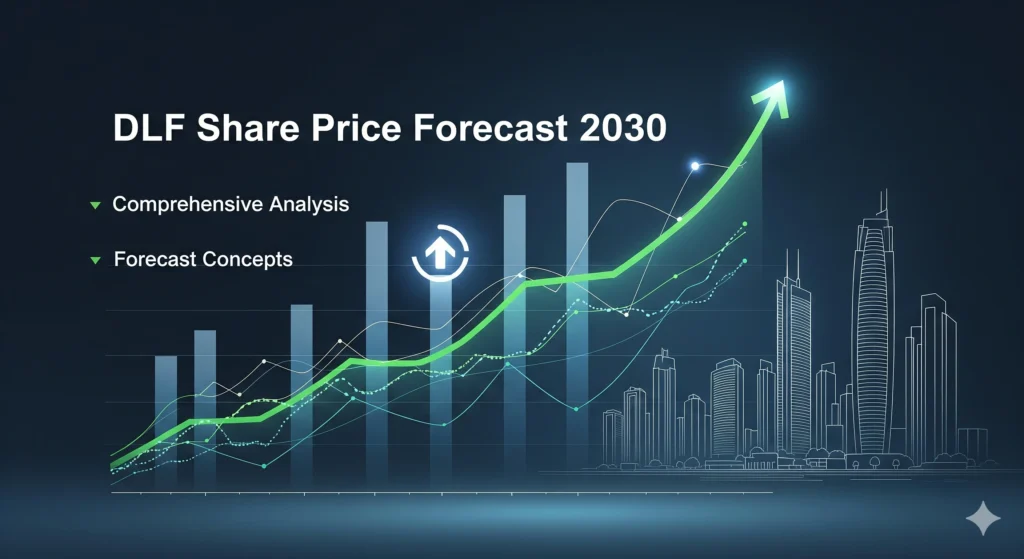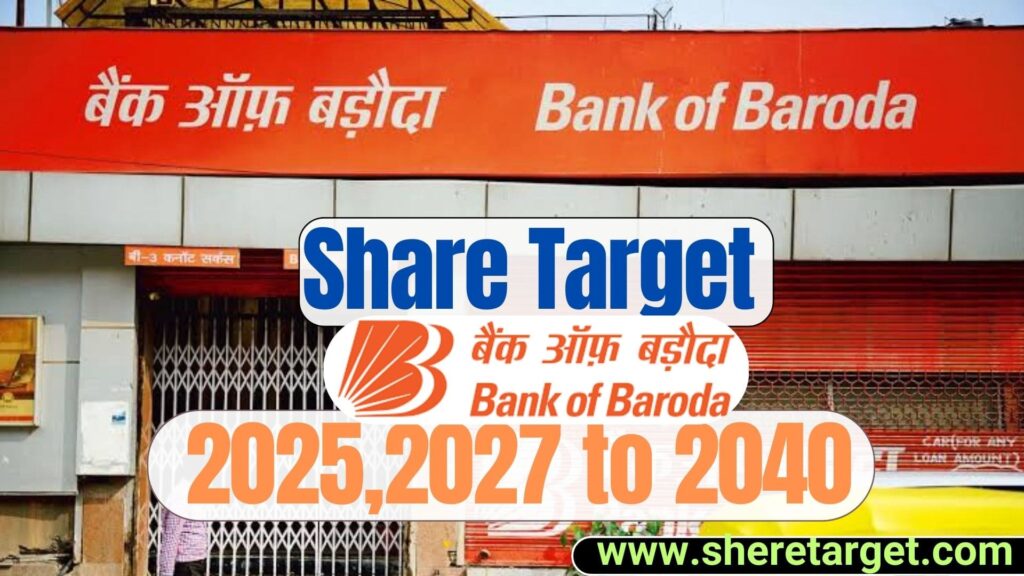Key Insights: DLF Share Analysis
- Current Price: ₹749.45 (as of August 28, 2025)
- Market Cap: ₹1,85,512 crore
- 5-Year Profit CAGR: 54.1%
- 2030 Price Target Range: ₹1,536 – ₹6,814
- Investment Outlook: Positive long-term with caution on valuation
- Key Risk Factors: Sector cyclicality, interest rate sensitivity
DLF Limited (DLF) is India’s largest listed real estate company and a central player for those interested in the share market’s real estate segment. This guide will help both novice and seasoned investors understand DLF’s fundamentals, market performance, future price targets, and the key factors influencing its stock—from quantitative analysis to qualitative expert forecasts.
DLF Share Overview
DLF Ltd. focuses on real estate development, including residential, commercial, and retail properties. As of August 28, 2025, DLF trades at ₹749.45 per share with a market capitalization of approximately ₹1,85,512 crore, and maintains a leadership position in India’s real estate sector. The company has a PE ratio of 41.65 and PB ratio of 4.39, signaling growth potential but also caution regarding valuation.
Fundamental Analysis of DLF Share
Financial Metrics (FY2025)
- Market Cap: ₹1.86 trillion
- Revenue (TTM): ₹93,480 million
- Net income (TTM): ₹44,847 million
- Dividend yield: 0.8%
- EPS: ₹18.11
- PE Ratio: 41.39
- ROE: 6.57%
- ROCE: 5.88%
Latest Expenditure and Net Cash Flow (FY25)
- Total Expenses: ₹6,193 million (latest quarter)
- Net Cashflow: −₹6,423 million (FY25)
Last Few Years’ Performance of DLF Share
Performance Trends
- DLF’s net profit grew at a CAGR of 54.1% over five years, signifying robust earnings momentum.
- Revenue climbed at an average rate of 7.9% per year, outperforming industry averages.
- Earnings growth rate stands above 43%, outpacing the sector.
Profit Growth
Profit after tax (PAT) has surged:
- FY2023: ₹20,358 million
- FY2024: ₹16,304 million
- FY2025: ₹26,945 million (65% YoY increase)
Sales Growth
DLF’s top line performed strongly:
- FY2023: ₹56,948 million
- FY2024: ₹64,270 million
- FY2025: ₹79,937 million (24.4% YoY growth)
Financial Performance Table
| Year | Revenue (₹ mn) | Net Income (₹ mn) | ROE (%) | ROCE (%) | Net Cashflow (₹ mn) |
|---|---|---|---|---|---|
| FY2021 | 54,141 | 10,936 | 1.37 | 4.00 | −5,731 |
| FY2022 | 57,174 | 15,009 | 2.35 | 4.35 | −7,294 |
| FY2023 | 56,948 | 20,358 | 2.97 | 4.67 | −985 |
| FY2024 | 64,270 | 16,304 | 4.23 | 5.91 | 11,865 |
| FY2025 | 79,937 | 26,945 | 6.57 | 5.88 | −6,423 |
ROE Trend
| Year | ROE (%) |
|---|---|
| 2021 | 1.37 |
| 2022 | 2.35 |
| 2023 | 2.97 |
| 2024 | 4.23 |
| 2025 | 6.57 |
ROCE Trend
| Year | ROCE (%) |
|---|---|
| 2021 | 4.00 |
| 2022 | 4.35 |
| 2023 | 4.67 |
| 2024 | 5.91 |
| 2025 | 5.88 |
Total Expenditure Amount
Latest reported:
- FY2025 Q1: ₹6,193 million
- FY2024 Q1: ₹5,698 million
The Net Cash Flow Amount
| Year | Net Cashflow (₹ mn) |
|---|---|
| 2021 | −5,731 |
| 2022 | −7,294 |
| 2023 | −985 |
| 2024 | 11,865 |
| 2025 | −6,423 |
Total Assets Amount
Though exact numbers for 2025 are not in the latest 24-hour data, previous reports suggest total asset levels well above ₹350,000 million, consistent with market cap and revenue scale.
DLF Share Price Target 2025–2050
| Year | Minimum Target (₹) | Maximum Target (₹) |
|---|---|---|
| 2025 | 820 | 1040 |
| 2026 | 1090 | 1350 |
| 2027 | 1550 | 1820 |
| 2028 | 1890 | 2120 |
| 2029 | 2380 | 2750 |
| 2030 | 4809 | 6814 |
| 2040 | 8,000 | 15,000 |
| 2050 | 15,000 | 28,000 |
(Note: targets vary widely between analysts—from WalletInvestor’s ₹1,536 for 2030, to bullish local analysts targeting up to ₹6,814 for 2030. Always check latest updates.)
DLF Share Price Good to Buy?
DLF can be a good pick for long-term investors seeking exposure to India’s growing real estate sector, provided they balance optimism with the risks of sector cyclicality and valuation. The company’s debt management, increasing luxury project revenues, and expanding rental portfolio support a bullish case for continued growth. However, its high PE ratio requires caution, and investors should diversify and avoid over-concentration.
Factors Influencing DLF Share
- Urban demand: Continued demand for upscale commercial, retail, and residential projects.
- Government policy: Real estate reforms, interest rate changes, and infrastructural push buoy demand.
- Corporate governance: DLF’s disciplined approach to debt and expansion reduces risk.
- Market cycles: Real estate is sensitive to economic ups and downs—expect some volatility.
Key Competitors of DLF Share
| Company | Market Cap (₹ crore) | Segment Coverage |
|---|---|---|
| Macrotech Dev | 80,000 | Residential/Commercial |
| Oberoi Realty | 60,000 | Residential/Luxury |
| Godrej Prop | 80,000 | Pan-India Residential |
| Prestige Est. | 52,000 | Southern States |
| Phoenix Mills | 35,000 | Retail/Malls |
Expert Forecasts on the Future of DLF Share
Bull Case
- Consistent profit and revenue growth aligned with India’s economic forecast.
- Sectoral tailwinds, rising rentals, joint ventures, and greenfield launches.
- Potential reach of ₹6,814 by 2030 if market conditions remain favorable.
Bear Case
- Sector slowdowns, over-leverage, regulatory headwinds.
- Potential stagnation below ₹1,500 in 2030 if sector underperforms.
- Volatility due to macroeconomic or interest rate shocks.
Conclusion
DLF remains a flagship script in India’s real estate portfolio and is favored by institutional investors. Its fundamentals are strong, its five-year growth is assertive, and its leadership in luxury and commercial segments sets it apart. However, the high valuation means possible underperformance if the real estate sector faces headwinds. For those looking for growth and reasonable risk management, DLF is worth consideration for medium- to long-term investment—but always diversify, monitor quarterly results, and avoid chasing extreme bullish forecasts.
FAQs
This comprehensive report uses the latest data and expert analyses to provide a thorough foundation for anyone considering DLF Ltd. shares in India’s evolving real estate sector.



